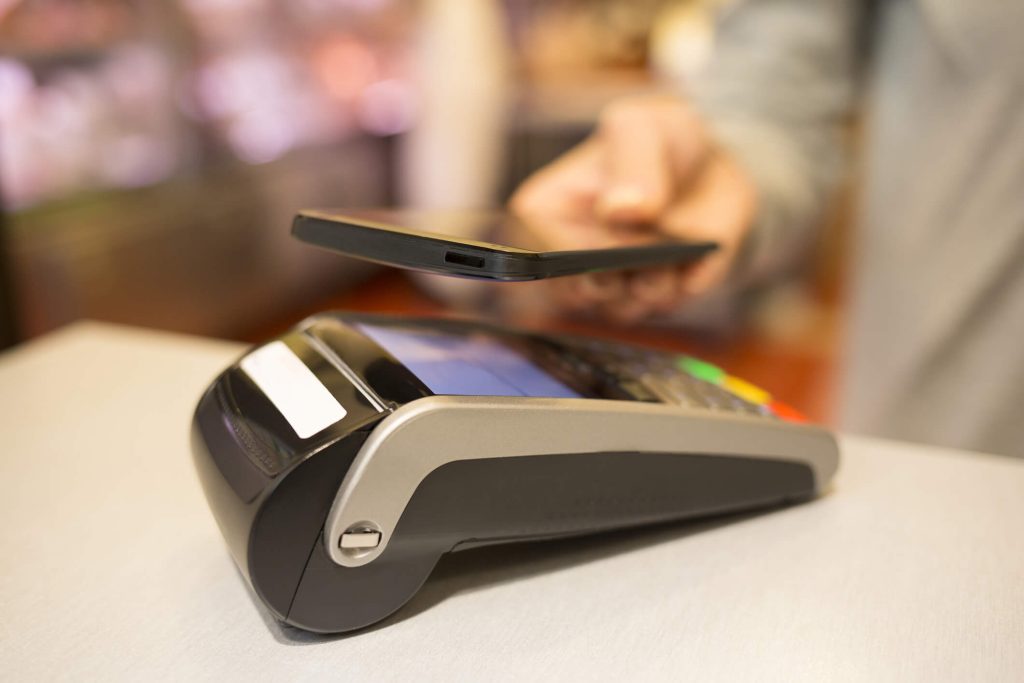In recent years, contactless payments have gained significant popularity across various industries, including the automotive sector. With the advancement of technology and changing consumer preferences, contactless payments have revolutionized the way we pay for goods and services. This article will explore the future of contactless payments in automotive businesses, discussing its rise, advantages, challenges, role of technology, integration best practices, security and privacy considerations, and future trends and predictions.
Understanding Contactless Payments: A Brief Overview
Contactless payments refer to transactions made using near-field communication (NFC) technology, allowing customers to make payments by simply tapping their contactless-enabled cards or mobile devices on a payment terminal. This technology eliminates the need for physical contact or the insertion of cards into a payment terminal, providing a faster and more convenient payment experience.
Contactless payments have gained popularity due to their speed, ease of use, and enhanced security features. According to a report by Juniper Research, contactless payments are expected to reach $6 trillion in transaction value by 2024, driven by increased adoption and acceptance by businesses across various sectors.
The Rise of Contactless Payments in the Automotive Industry

The automotive industry has witnessed a significant rise in the adoption of contactless payments. From fuel stations to car washes, automotive businesses are embracing this technology to enhance customer experience and streamline payment processes. Contactless payments offer several benefits for automotive businesses, making them an attractive option for both customers and businesses.
Advantages of Contactless Payments for Automotive Businesses
- Speed and Convenience: Contactless payments enable faster transactions, reducing waiting times for customers. This is particularly beneficial for businesses with high customer volumes, such as fuel stations or car washes.
- Enhanced Customer Experience: Contactless payments provide a seamless and frictionless payment experience, improving customer satisfaction and loyalty. Customers appreciate the convenience of tapping their cards or mobile devices, eliminating the need for cash or physical cards.
- Increased Efficiency: Contactless payments streamline payment processes, reducing the need for manual handling of cash or card transactions. This improves operational efficiency for automotive businesses, allowing them to serve more customers in less time.
- Cost Savings: By adopting contactless payments, automotive businesses can reduce the costs associated with cash handling, such as cash counting, security, and transportation. This can result in significant cost savings in the long run.
- Improved Security: Contactless payments offer enhanced security features, including tokenization and encryption, making them more secure than traditional payment methods. This reduces the risk of fraud and unauthorized access to customer payment information.
Challenges and Concerns Surrounding Contactless Payments in the Automotive Sector

While contactless payments offer numerous advantages, there are also challenges and concerns that automotive businesses need to address:
- Infrastructure and Integration: Automotive businesses need to invest in the necessary infrastructure, including contactless payment terminals and software integration, to accept contactless payments. This can be a significant upfront cost for some businesses.
- Consumer Adoption: While contactless payments have gained popularity, there are still consumers who are hesitant to adopt this technology. Automotive businesses need to educate and incentivize customers to use contactless payments to drive adoption.
- Connectivity Issues: Contactless payments rely on a stable internet connection for real-time transaction processing. In areas with poor connectivity, automotive businesses may face challenges in accepting contactless payments.
- Security Concerns: Despite the enhanced security features of contactless payments, there are still concerns regarding data breaches and unauthorized access to customer payment information. Automotive businesses need to implement robust security measures to protect customer data.
The Role of Technology in Driving Contactless Payments in Automotive Businesses
Technology plays a crucial role in driving the adoption and integration of contactless payments in automotive businesses. Here are some key technologies that are shaping the future of contactless payments:
- Near-Field Communication (NFC): NFC technology enables contactless communication between devices, allowing customers to make payments by tapping their contactless-enabled cards or mobile devices on payment terminals. NFC technology is widely used in contactless payment systems.
- Mobile Wallets: Mobile wallets, such as Apple Pay and Google Pay, enable customers to store their payment information securely on their mobile devices. Automotive businesses can integrate their payment systems with mobile wallets to offer a seamless payment experience.
- Internet of Things (IoT): IoT technology can be leveraged to connect payment terminals, vehicles, and other devices, enabling seamless and secure contactless payments. For example, connected cars can be equipped with NFC-enabled payment systems, allowing customers to make payments directly from their vehicles.
- Biometric Authentication: Biometric authentication, such as fingerprint or facial recognition, adds an extra layer of security to contactless payments. Automotive businesses can integrate biometric authentication into their payment systems to enhance security and prevent unauthorized access.
Integrating Contactless Payments into Automotive Services: Best Practices
To successfully integrate contactless payments into their existing infrastructure, automotive businesses should consider the following best practices:
- Assess Business Needs: Evaluate the specific payment requirements of your automotive business and identify the areas where contactless payments can add value. This could include fuel stations, car washes, maintenance services, or even in-vehicle payment options.
- Choose the Right Payment Solution: Select a contactless payment solution that aligns with your business needs and integrates seamlessly with your existing systems. Consider factors such as cost, security features, ease of use, and compatibility with different payment methods.
- Educate and Incentivize Customers: Educate your customers about the benefits of contactless payments and incentivize them to adopt this technology. Offer discounts, loyalty rewards, or exclusive promotions for customers who choose to pay using contactless methods.
- Train Staff: Provide comprehensive training to your staff on how to use and troubleshoot contactless payment systems. This will ensure a smooth transition and minimize any potential issues during the implementation phase.
- Monitor and Analyze Data: Regularly monitor and analyze transaction data to gain insights into customer preferences and behavior. This data can help you optimize your contactless payment processes and tailor your services to meet customer demands.
Security and Privacy Considerations in Contactless Payments for Automotive Businesses

Security and privacy are paramount when it comes to contactless payments in the automotive industry. Automotive businesses must implement robust security measures to protect customer payment information and prevent unauthorized access. Here are some key considerations:
- Encryption and Tokenization: Implement encryption and tokenization techniques to secure customer payment data. Encryption ensures that sensitive information is transmitted securely, while tokenization replaces card details with unique tokens, reducing the risk of data breaches.
- Compliance with Payment Card Industry Data Security Standard (PCI DSS): Ensure that your contactless payment systems comply with PCI DSS, a set of security standards designed to protect cardholder data. Compliance with PCI DSS helps mitigate the risk of data breaches and ensures the security of customer payment information.
- Regular Security Audits: Conduct regular security audits to identify vulnerabilities in your contactless payment systems. This includes testing for potential weaknesses in network security, software vulnerabilities, and physical security measures.
- Customer Consent and Privacy Policies: Obtain customer consent for collecting and storing their payment information and clearly communicate your privacy policies. Ensure that customers are aware of how their data will be used and protected.
The Future of Contactless Payments in Automotive Businesses: Trends and Predictions
The future of contactless payments in the automotive industry looks promising, with several trends and predictions shaping its trajectory:
- In-Vehicle Payment Systems: As connected cars become more prevalent, in-vehicle payment systems will gain traction. Customers will be able to make payments for fuel, tolls, parking, and other automotive services directly from their vehicles, enhancing convenience and reducing the need for physical payment methods.
- Integration with Mobility Services: Contactless payments will be integrated into mobility services, such as ride-hailing and car-sharing platforms. This will enable seamless and secure payments for transportation services, eliminating the need for cash or card transactions.
- Biometric Authentication: Biometric authentication, such as fingerprint or facial recognition, will become more prevalent in contactless payment systems. This will enhance security and provide a more personalized payment experience for customers.
- Continued Growth of Mobile Wallets: Mobile wallets will continue to grow in popularity, with more customers opting to store their payment information on their mobile devices. Automotive businesses will need to ensure compatibility with popular mobile wallet platforms to cater to customer preferences.
- Enhanced Data Analytics: Advanced data analytics will enable automotive businesses to gain deeper insights into customer behavior and preferences. This data can be used to personalize services, optimize payment processes, and drive customer loyalty.
FAQs:
Q.1: What are contactless payments, and how do they work in the automotive industry?
A: Contactless payments refer to transactions made using near-field communication (NFC) technology, allowing customers to make payments by tapping their contactless-enabled cards or mobile devices on a payment terminal. In the automotive industry, contactless payments can be used for various services, such as fuel stations, car washes, maintenance services, and in-vehicle payments.
Q.2: Are contactless payments secure for automotive businesses?
A: Contactless payments offer enhanced security features, including encryption and tokenization, making them more secure than traditional payment methods. However, automotive businesses must implement robust security measures, comply with industry standards, and regularly monitor and update their systems to ensure the security of customer payment information.
Q.3: How can automotive businesses integrate contactless payment systems into their existing infrastructure?
A: Automotive businesses can integrate contactless payment systems by investing in the necessary infrastructure, such as contactless payment terminals and software integration. They should choose a payment solution that aligns with their business needs, educate and incentivize customers to use contactless payments, and provide comprehensive training to staff. Regular monitoring and analysis of transaction data can help optimize the payment processes.
Q.4: What are the benefits of contactless payments for automotive businesses?
A: Contactless payments offer several benefits for automotive businesses, including speed and convenience, enhanced customer experience, increased efficiency, cost savings, and improved security. They streamline payment processes, reduce waiting times, and eliminate the need for cash handling, resulting in operational efficiency and customer satisfaction.
Conclusion
Contactless payments have revolutionized the way we pay for goods and services, and the automotive industry is no exception. With their speed, convenience, and enhanced security features, contactless payments offer numerous advantages for automotive businesses. Despite the challenges and concerns surrounding this technology, the role of technology, integration best practices, and security considerations can help businesses successfully adopt contactless payment systems.
